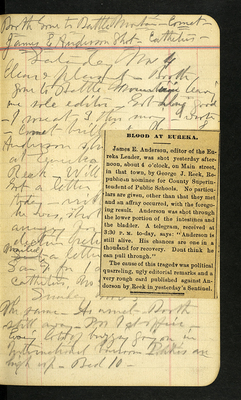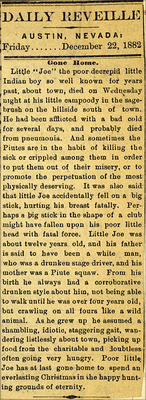Pages
36
[Daily Reveille, Austin, Nevada, Saturday, November 4, 1882]
BLOOD AT EUREKA.
James E. Anderson, editor of the Eureka Leader, was shot yesterday afternoon, about 4 o'clock, on Main street, in that town, by George J. Reek, Republican nominee for County Superintendent of Public Schools. No particulars are given, other than that they met and an affray occurred, with the foregoing result. Anderson was shot through the lower portion of the intestines and the bladder. A telegram, received at 3:30 P. M. to-day, says: "Anderson is still alive. His chances are one in a thousand for recovery. Dont think he can pull through."
The cause of this tragedy was political quarreling, ugly editorial remarks and a very rough card published against Anderson by Reek in yesterday's Sentinel.
37
[Daily Reveille, Austin, Nevada, undated 1882]
A Steep Railroad Grade.
Bob Lindsay, the famous Reno lawyer, who returned home from his visit to Austin this morning, was perfectly astonished at the steepness of our local railroad up Main street. He has been used to seeing the Central Pacific, the Virginia & Truckee, and other roads in the western portion of the State, with their comparatively flat grades of about 116 feet to the mile, therefore our Austin street railroad, with its steep grade of one foot in 12, seemed to Bob something outrageously wonderful. He considers it a little the loftiest climbing in the world for any locomotive to do on a plain track, and he is about right. Yet at one time to-day that gallant little locomotive took up two carloads of heavy nut-pine wood, 12 cords, without much trouble.
38
DAILY REVEILLE
AUSTIN, NEVADA:
Friday . . . . . . .December 22, 1882
Gone Home.
Little "Joe" the poor decrepid little Indian boy so well known for years past, about town, died on Wednesday night at his little campoody in the sagebrush on the hillside south of town. He had been afflicted with a bad cold for several days, and probably died from pneumonia. And sometimes the Piutes are in the habit of killing the sick or crippled among them in order to put them out of their misery, or to promote the perpetuation of the most physically deserving. It was also said that little Joe accidentally fell on a big tick, hurting his breast fatally. Perhaps by big stick in the shape of a club might have fallen upon his poor little head with fatal force. Little Joe was about twelve years old, and his father is said to have been a white man, who was a drunken stage driver, and his mother was a Piute squaw. From his birth he always had a corroborative drunken style about him, not being able to walk until he was over four years old, but crawling on all fours like a wild animal. As he grew up he assumed a shambling, idiotic, staggering gait, wandering listlessly about town, picking up food from the charitable and doubtless often going very hungry. Poor little Joe has at last gone home to spend an everlasting Christmas in the happy hunting grounds of eternity.
39
DAILY REVEILLE
AUSTIN, NEVADA:
Thursday . . . . .December 28, 1882
AN INTERESTING CASE.
H. S. Horton, brother to R. L. Horton, one of our Austin grocers, whose arrival here from Montana, some weeks ago, was mentioned in this paper, met with a terrible accident thirteen years ago at Deer Lodge, Montana, the results of which were both severe and peculiar. He fell from the top floor of the second story of the McBurney House, then in process of erection down into the cellar, and was picked up for dead. But he was not dead at all. He only had both legs broken in three or four places, both arms and several ribs broken and his scalp badly torn, besides sustaining numerous other severe contusions and lacerations. The doctor considered him too much damaged to be worth repairing, or for any sort of use except as a funeral subject, but Horton ordered him to go to work and fix up his bones forthwith, or he would break his head as soon as he could get up. The result was that in due course of time Horton was able to use one arm, then the other, then raise up a little and after awhile longer get out on crutches, and finally, in the course of two or three years got over being even lame, and became apparently as strong and able as ever in limbs and body.
But one trouble still remained with him, proceeding from the severe contusion and cut received on his head at the time of the accident. His skull was not fractured, but the outer surface of the bone, on the upper left hand side, as well as the scalp, had evidently received an injury of considerable permanency. It did not heal properly and a tumor formed which gradually increased in size, growing more and more rapidly, especially during the last year or two. It pained and troubled him considerably until at last he concluded to go to San Francisco for treatment. On his way thither he switched off at Battle Mountain and came to Austin to visit his brother whom he had not seen for many years. Several surgeons in Montana had examined the tumor with a view to its removal but Horton was afraid to trust them. Shortly after his arrival here it was suggested that we had some pretty good surgeons in Austin. He submitted to an examination and concluded to have the operation performed.
Being a man of excellent nerve, he refused chloroform and sat up like a martyr while the surgeon skillfully did his work. The tumor was found to be growing fast to the skull and had to be entirely dissected out, but it was successfully removed. Horton lost over a quart of blood, yet experienced no bad effects, but on the contrary felt relieved as soon as the surgeon had concluded. This was three weeks ago, since which time the scalp wound has been healing up finely, and the patient now feels all right and in the enjoyment of better health than he has had for three or four years. He is now of the opinion that as good surgery can be found in Austin as in San Francisco, and perhaps better. The tumor was of the kind surgically known as "benign," in contradistinction to the "malignant" forms of tumors. It is the size of a large goose egg, nearly round, flattened where it grew to the skull, and its interior seems to be of a soft fleshy character, interspersed with a reddish fluid matter. It is now preserved in a jar of alcohol in the surgeon's office, and Horton is mighty proud of it–where it is.





